CANDY CS4 H7 A1 DE-S User Manual [nl]
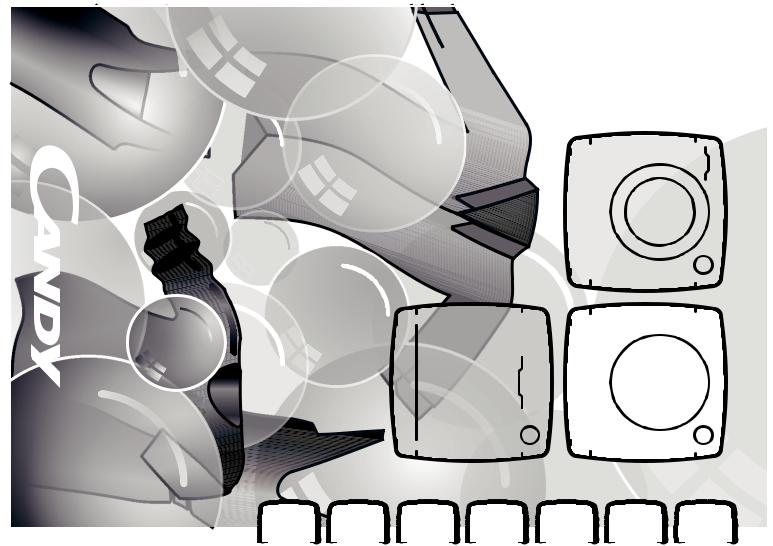
ES |
PT |
NL |
IT |
DE |
FR |
EN |

Please read and follow these instructions carefully and operate the machine accordingly. This booklet provides important guidelines for safe use, installation, maintenance and some useful advice for best results when using your machine.
Keep all documentation in a safe place for future reference or for any future owners.
Please check that the following items are delivered with the appliance:
●Instruction manual
●Guarantee card
●Energy label
By placing the 
 mark on this product, we are confirming compliance to all relevant European safety, health and environmental requirements which are applicable in legislation for this product.
mark on this product, we are confirming compliance to all relevant European safety, health and environmental requirements which are applicable in legislation for this product.
 Check that no damage has occurred to the machine during transit. If it has, call for service by GIAS. Failure to comply with the above can compromise the safety of the appliance. You may be charged for a service call if a problem with your machine is caused by misuse.
Check that no damage has occurred to the machine during transit. If it has, call for service by GIAS. Failure to comply with the above can compromise the safety of the appliance. You may be charged for a service call if a problem with your machine is caused by misuse.
Index
1.SAFETY REMINDERS
2.DRAIN HOSE KIT: FITTING INSTRUCTIONS
3.PREPARING THE LOAD
4.CLEANING AND ROUTINE MAINTENANCE
5.WATER CONTAINER
6.DOOR AND FILTER AND CONDENSER
7.CONTROLS AND INDICATORS
8.SELECTING THE PROGRAMME AND SET THE FUNCTION
9.TROUBLESHOOTING CUSTOMER SERVICE
2

1.SAFETY REMINDS
●This appliance can be used by children aged from 8 years and above and persons with reduced physical,sensory or mental capabilities or lack of experience and knowledge if they have been given supervision or instruction concerning use of the appliance in a safe way and understand the hazards involved.Children shall not play with the appliance. Cleaning and user maintenance should not be made by children without supervision.Children of less than 3 years should be kept away unless continuously supervised.
●WARNING Misuse of a tumble dryer may create a fire hazard.
●This appliances is intended to be used in household and similar
applications such as:
-Staff kitchen areas in shops , offices and other working environments;
-Farm houses
-By clients in hotels, motels and
o t h e r r e s i d e n t i a l t y p e environments;
- Bed and breakfast type environments" A different use of this appliance from house hold
environment or |
from typical |
housekeeping |
functions,as |
commercial use by |
e x p e r t o r |
trained users, is excluded even in the above applications.
If the appliance is used in a manner inconsistent with this it
may reduce the life of the appliance and may void the manufacturer’s warranty.
Any damage to the appliance or other damage or loss arising through use that is not consistent with domestic or household use ( even if located in a domestic or household environment) shall not be accepted by the manufacturer to the fullest extent permitted by law.
●This machine should only be used for its intended purpose as described in this manual. Ensure that the instructions for installation and use are fully understood before operating the appliance.
●Do not touch the appliance when hands or feet are damp or wet.
●Do not lean on the door when loading the machine or use the door to lift or move the machine.
●Do not allow children to play with the machine or its
controls.
EN
3
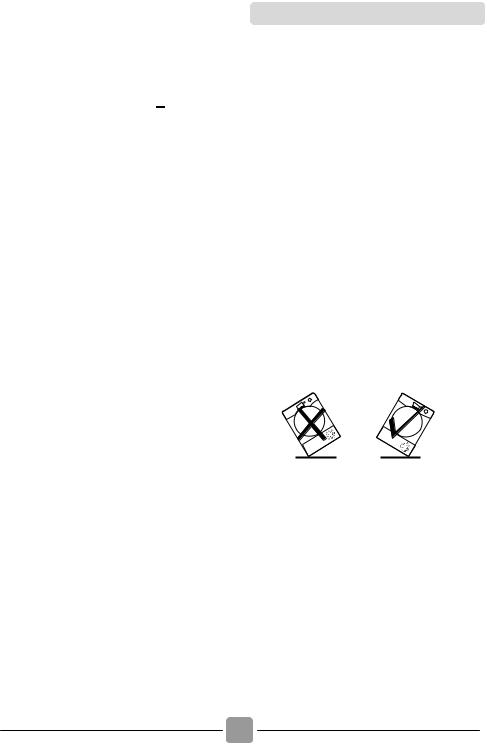
●WARNING Do not use the product if the fluff filter is not in position or is damaged; fluff could be ignited.
●WARNING Where the hot surface symbol is  located the temperature rise during
located the temperature rise during
operation of the tumble dryer may be in excess of 60 degrees
C.
●Remove the plug from the electricity supply. Always remove the plug before cleaning the appliance.
Installation
●Do not use adapters, multiple connectors and/or extensions.
●Never install the dryer against curtains and be sure to prevent items from falling or collecting behind the dryer.
●The appliance must not be installed behind a lockable door, a sliding door or a door with a hinge on the opposite side to that of the tumble dryer.
●Do not continue to use this machine if it appears to be faulty.
●Lint and fluff must not be Important: During transport allowed to collect on the floor ensure that the dryer is in an
around the outside of the machine.
●The final part of a tumble dryer cycle occurs without heat (cool down cycle) to ensure that the items are left at a temperature that ensures that the items will not be damaged.
●The tumble dryer is not to be used if industrial chemicals have been used for cleaning.
●WARNING: Never stop a tumble dryer before the end of the drying cycle unless all items are quickly removed and spread out so that the heat is dissipated.
●Maximum load drying weight: see energy label.
upright position, if it's necessary you can only flip in the side shown;
Caution: If the product is in different side, wait at least 4 hours before switching on so that the oil c a n f l o w b a c k i n t o t h e compressor. Failure to do this could result in damage to the compressor.
4

The Laundry |
|
|
|
|
|
|
|
washed in hot water with an |
||||||||
● Do not dry unwashed items in |
|
extra amount |
of |
detergent |
||||||||||||
|
before being dried in the |
|||||||||||||||
the tumble dryer. |
|
|
|
|
|
tumble dryer. |
|
|
|
|
||||||
● WARNING Do not tumble dry |
● Fabric softeners, or similar |
|||||||||||||||
fabrics treated with dry cleaning |
|
products, should be used as |
||||||||||||||
fluids. |
|
|
|
|
|
|
|
|
|
specified |
by |
the |
fabric |
|||
● WARNING |
Foam |
rubber |
|
softener instructions. |
|
|
||||||||||
materials |
can, |
under |
certain |
|
|
|
|
|
|
|
|
|||||
circumstances, |
when |
heated |
|
|
|
|
|
|
|
|
||||||
b e c o m e |
i g n i t e d |
b y |
|
Ventilation |
|
|
|
|
|
|||||||
spontaneous |
combustion. |
● Adequate ventilation must be |
||||||||||||||
Items such as foam rubber |
||||||||||||||||
(latex |
foam), |
shower |
caps, |
|
provided in the room where |
|||||||||||
waterproof |
textiles, |
rubber |
|
the tumble dryer is located to |
||||||||||||
backed articles and clothes or |
|
p r e v e n t |
g a s e s |
f r o m |
||||||||||||
pillows fitted with foam rubber |
|
appliances |
burning |
other |
||||||||||||
pads MUST NOT be dried in the |
|
fuels, including open |
fires, |
|||||||||||||
tumble dryer. |
|
|
|
|
|
|
|
being drawn into the room |
||||||||
● Always refer to the laundry care |
|
during |
operation of |
the |
||||||||||||
labels |
for |
directions |
on |
|
tumble dryer. |
|
|
|
|
|||||||
suitability for drying. |
|
|
|
|
● Installing the |
rear |
of the |
|||||||||
● Clothes should be spin dried or |
|
appliance close to a wall or |
||||||||||||||
thoroughly |
wrung before |
they |
|
vertical surface. |
|
|
|
|||||||||
are put into the tumble dryer. |
● There should be a gap of at |
|||||||||||||||
● Clothes that are dripping wet |
|
least 12 mm between the |
||||||||||||||
should not be put into the dryer. |
|
m a c h i n e |
a n d |
|
a n y |
|||||||||||
Lighters and matches must not |
|
obstrubtions.The |
inlet |
and |
||||||||||||
be left in pockets and NEVER |
|
outlet should be kept clear of |
||||||||||||||
use flammable liquids near the |
|
o b s t r u c t i o n . To |
e n s u r e |
|||||||||||||
machine. |
|
curtains |
should |
|
adequate |
ventilation |
the |
|||||||||
● Glass |
fibre |
|
space between the bottom of |
|||||||||||||
NEVER be put in this machine. |
|
the machine and the floor |
||||||||||||||
Skin irritation may occur if other |
|
must not be obstructed. |
|
|||||||||||||
garments |
are |
contaminated |
● Check regularly that the air |
|||||||||||||
with the glass fibres. |
|
|
|
|
|
flowing through the dryer is |
||||||||||
● Items that have been soiled |
|
not restricted. |
|
|
|
|
||||||||||
with substances |
such |
as |
● Check |
frequently |
the |
fluff |
||||||||||
cooking oil, acetone, alcohol, |
|
filter after use, and clean, if |
||||||||||||||
p e t r o l , k e r o s e n e , |
s p o t |
|
necessary. |
|
|
|
|
|
||||||||
removers, |
turpentine, |
waxes |
● Prevent items from falling or |
|||||||||||||
and wax removers should be |
|
collecting behind the dryer as |
||||||||||||||
|
|
|
|
|
|
|
|
|
5 |
|
|
|
|
|
|
|
|
|
|
|
|
|
|
|
|
|
|
|
|
|
|
|
|
EN
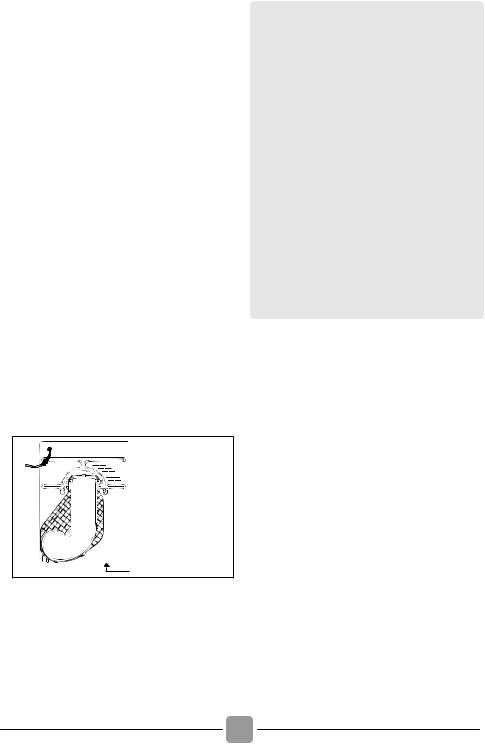
these may obstruct the air inlet and outlet
●NEVER install the dryer up against curtains.
●In cases where the dryer is installed on top of a washing machine, a suitable stacking kit must be used according to the follow configuration.
-Stacking kit Mod 35100019: for minimum washing machine depth 49 cm
-Stacking kit Mod 35900120: for minimum washing machine depth 51 cm
The stacking kit shall be one of that above, obtainable from our spare service.
The instructions for installation and any fixing attachments, are provided with the staking kit.
 Do not install the product in a low temperature room or in a room where there is a risk of frost occurring. At temperature around freezing point the product may not be able to operate properly: there is a risk of damage if the water is allowed to freeze in the hydraulic circuit (valves, hoses, pumps). For a better product performance the ambient room temperature must be between 5-35°C. Please note that operating in cold condition
Do not install the product in a low temperature room or in a room where there is a risk of frost occurring. At temperature around freezing point the product may not be able to operate properly: there is a risk of damage if the water is allowed to freeze in the hydraulic circuit (valves, hoses, pumps). For a better product performance the ambient room temperature must be between 5-35°C. Please note that operating in cold condition
(between +2 and +5°C) might simply some water condensation and water drops on floor.
Air Outlets in the Base
6
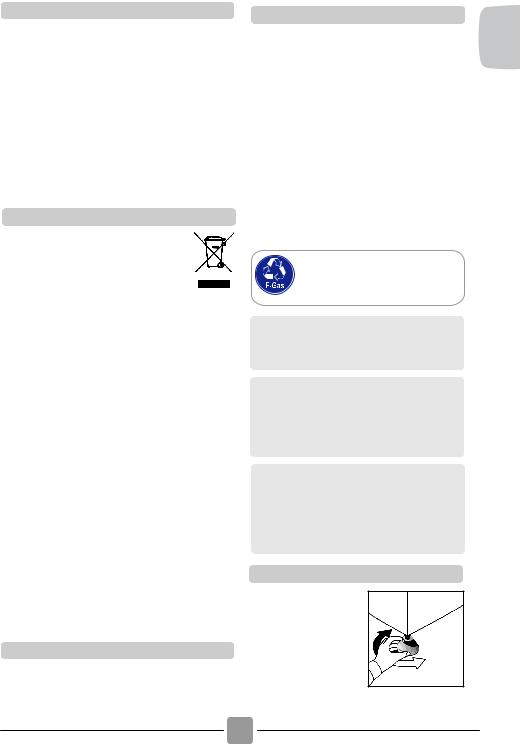
Environmental Issues
●All packaging materials used are environmentally-friendly and recyclable. Please help dispose of the packaging via environmentally-friendly means. Your local council will be able to give you details of current means of disposal.
●To ensure safety when disposing of an old tumble dryer disconnect the mains plug from the socket, cut the mains power cable and destroy this together with the plug. To prevent children shutting themselves in the machine break the door hinges or the door lock.
European Directive 2012/19/EU
This appliance is marked according to the European directive 2012/19/EU on Waste Electrical and Electronic Equipment (WEEE).
WEEE contains both polluting substances (which can cause negative consequences for the environment) and basic components (which can be re-used). It is important to have WEEE subjected to specific treatments, in order to remove and dispose properly all pollutants, and recover and recycle all materials.
Individuals can play an important role in ensuring that WEEE does not become an environmental issue; it is essential to follow some basic rules:
-WEEE should not be treated as household waste.
-WEEE should be handed over to the relevant collection points managed by the municipality or by registered companies. In many countries, for large WEEE, home collection could be present.
In many countries, when you buy a new appliance, the old one may be returned to the retailer who has to collect it free of charge on a one-to-one basis, as long as the equipment is of equivalent type and has the same functions as the supplied equipment.
GIAS Service
●To ensure the continued safe and efficient operation of this appliance we recommend that any servicing or repairs are only carried out by an authorised GIAS service engineer.
Electrical Requirements
Tumble dryers are supplied to operate at a voltage of 220-240V, 50 Hz single phase. Check that the supply circuit is rated to at least 6 A.
Electricity can be extremely dangerous. This appliance must be earthed.
The socket outlet and the plug on the appliance must be of the same type.
Do not use multiple adapters and/or extension leads.
The plug should be accessible for disconnection after the appliance has been installed.
C o n t a i n s f l u o r i n a t e d g r e e n h o u s e g a s e s . Hermetically sealed.
 GWP1430
GWP1430
 You may be charged for a service call if a problem with your machine is caused by incorrect installation.
You may be charged for a service call if a problem with your machine is caused by incorrect installation.
 If the mains cord on this appliance is damaged, it must be replaced by a special cord which is ONLY obtainable from the spares service. It must be installed by a competent person.
If the mains cord on this appliance is damaged, it must be replaced by a special cord which is ONLY obtainable from the spares service. It must be installed by a competent person.
 Do not plug the machine in and switch it on at the mains until the installation is completed.For your safety, this dryer must be correctly installed. If there is any doubt about installation, call GIAS Service for advice.
Do not plug the machine in and switch it on at the mains until the installation is completed.For your safety, this dryer must be correctly installed. If there is any doubt about installation, call GIAS Service for advice.
Adjusting the Feet
Once the machine is in place the feet should be adjusted to e n s u r e t h a t t h e machine is level.
EN
7
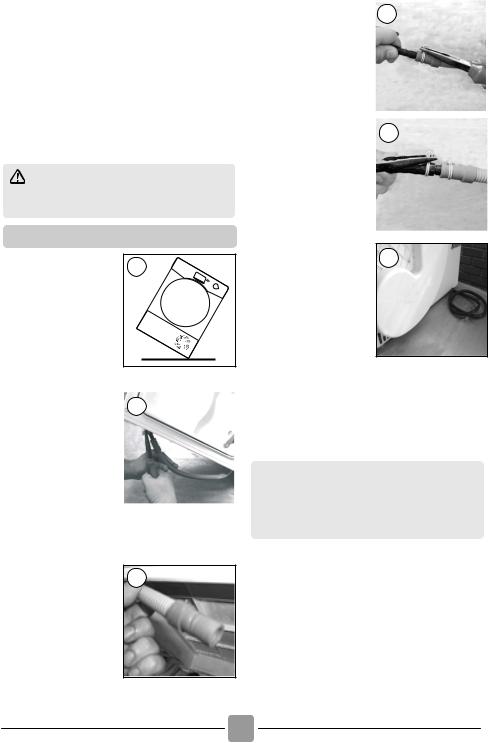
2. DRAIN HOSE : FITTING
INSTRUCTIONS
To avoid emptying the water container after each drying cycle, the water can be discharged directly to a waste water drain pipe (the same drainage system as household sinks). Water Bye-Laws prohibit connection to a surface water drain. The waste water drain pipe should be located adjacent to the tumble dryer.
The kit consists of:1 hose and 1 tap.
WARNING! Switch off and remove the tumble dryer plug from the electricity supply before carrying out any work.
Fit the Hose as Follows:
1. Flip the machine slowly to the right side.
1 |
4. Attach |
the black |
4 |
|
hose from the |
kit, |
||
(using the |
connector |
|
|
a n d p i p e c l i p s |
|
||
supplied), to the hose |
|
||
removed |
from |
the |
|
bridge connection. |
|
||
|
|
|
|
|
|
|
|
5. Connect |
the |
new |
5 |
drain hose to the waste |
|
||
Water pipe. |
|
|
|
|
|
|
|
6. Once the machine is
in place, check the 6 bottom to ensure that
the new hose does not kink when pushing the tumble dryer into position.
Connect to the mains electricity supply.
2. The |
waste water |
2 |
|
pipe is situated at the |
|||
right-hand side of the |
|
||
machine (see |
the |
|
|
picture). A grey hose |
|
||
connects to the bridge |
|
||
at the left hand side of |
|
||
the machine. Using |
|
||
pliers, |
remove |
the |
|
|
|||
pipe |
retaining |
clip |
|
from the bridge.
Caution: If the product is in different side, wait at least 4 hours before switching on so that the oil can flow back into the compressor. Failure to do this could result in damage to the compressor.
3
3. Pull the hose off the bridge connection.
8

3. PREPARING THE LOAD
Before using the tumble dryer for the first time:
●Please read this instruction book thoroughly.
●Remove all items packed inside drum.
●Wipe the inside of the drum and door with a damp cloth to remove any dust which may have
settled in transit.
Clothes Preparation
Make sure that the laundry you are going to dry is suitable for drying in a tumble dryer, as shown by the care symbols on each item.
Check that all fastenings are closed and that pockets are empty. Turn the articles inside out. Place clothes loosely in the drum to make sure that they don't get tangled.
Do Not Tumble Dry:
Silk, nylon stockings, delicate embroidery, fabrics with metallic decorations, garments with PVC or leather trimmings.
 IMPORTANT: Do not dry articles which have been treated with a dry cleaning fluid or rubber clothes (danger of fire or explosion).
IMPORTANT: Do not dry articles which have been treated with a dry cleaning fluid or rubber clothes (danger of fire or explosion).
During the last 15 minutes the load is always tumbled in cool air.
Energy Saving
Only put into the tumble dryer laundry which has been thoroughly wrung or spin-dried. The drier the laundry the shorter the drying time thus saving electricity.
ALWAYS
●Check that the filter is clean before every drying cycle.
NEVER
●Put dripping wet items into the tumble dryer, this may damage the appliance.
Sort the Load as Follows
● By care symbols
These can be found on the collar or inside seam:
Suitable for tumble drying.
. . Tumble drying at high temperature.
.Tumble drying at low temperature only.
Do not tumble dry.
If the item does not have a care label it must be assumed that it is not suitable for tumble drying.
● By amount and thickness
Whenever the load is bigger than the dryer capacity, separate clothes according to thickness (e.g. towels from thin underwear).
● By type of fabric
Cottons/linen: Towels, cotton jersey, bed and table linen.
Synthetics: Blouses, shirts, overalls, etc. made of polyester or polyamid, as well as for cotton/synthetic mixes.
 Do not overload the drum, large items when wet exceed the maximum admissible clothes load (for example: sleeping bags, duvets).
Do not overload the drum, large items when wet exceed the maximum admissible clothes load (for example: sleeping bags, duvets).
4.CLEANING AND ROUTINE MAINTENANCE
Cleaning the Dryer
● Clean the filter and empty the water container after every
drying cycle.
●Regularly clean the condenser.
●After each period of use, wipe the inside of the drum and leave the door open for a while to allow circulation of air to dry it.
●Wipe the outside of the machine and the door with a soft cloth.
●DO NOT use abrasive pads or cleaning agents.
●To prevent the door sticking or the build up of fluff clean the inner door and gasket with a damp cloth after every drying cycle.
 WARNING! The Drum, door and load may be very hot.
WARNING! The Drum, door and load may be very hot.
 IMPORTANT Always switch off and remove the plug from the electricity supply before cleaning this appliance.
IMPORTANT Always switch off and remove the plug from the electricity supply before cleaning this appliance.
 For electrical data refer to the rating label on the front of the dryer cabinet (with the door open).
For electrical data refer to the rating label on the front of the dryer cabinet (with the door open).
EN
9
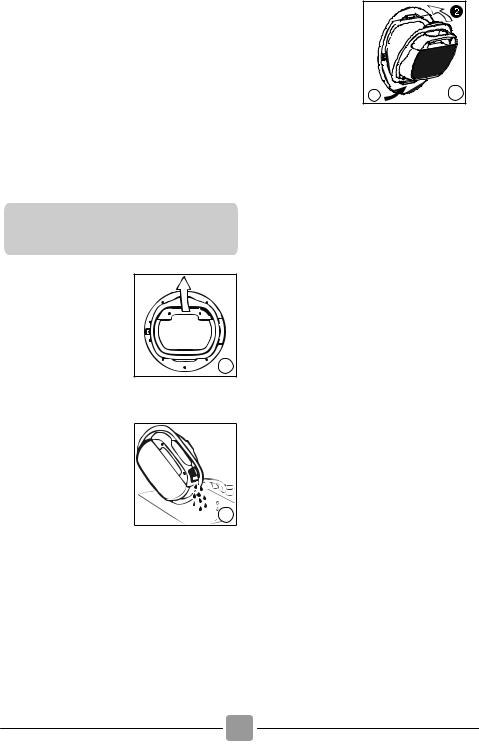
5. WATER CONTAINER
The water removed from the laundry during the drying cycle is collected in a container inside the door of the dryer. When the container is full the  indicator on the control panel will light, and the container MUST be emptied. However, we recommend that the container is emptied after each drying cycle.
indicator on the control panel will light, and the container MUST be emptied. However, we recommend that the container is emptied after each drying cycle.
NOTE: Very little water will collect during the first few cycles of a new machine as an internal reservoir is filled first.
NOTE: If you |
have |
|
|
the option of drainage |
|
||
near to the dryer you |
|
||
c a n |
u s e |
t h e |
|
d i s c h a r g e k i t t o |
|
||
provide a permanent |
|
||
drainage for the water |
C |
||
c o l l e c t e d i n t h e 1 |
|||
container of the dryer. |
|
||
This |
means that you |
|
|
don't have to empty the water container.
To remove the container tank in door drawer
1. Gently pull out the water container holding the handle. (A)
When it is full the water container will weigh about 6 kg.
2. T i l t t h e w a t e r container to empty the water out through the spout. (B)
When empty, replace the water container back as shown; (C) first insert the base of the container into position as shown (1) then gentle push the top into position (2).
3. Press  Button to restart the cycle.
Button to restart the cycle.
A
 B
B
10
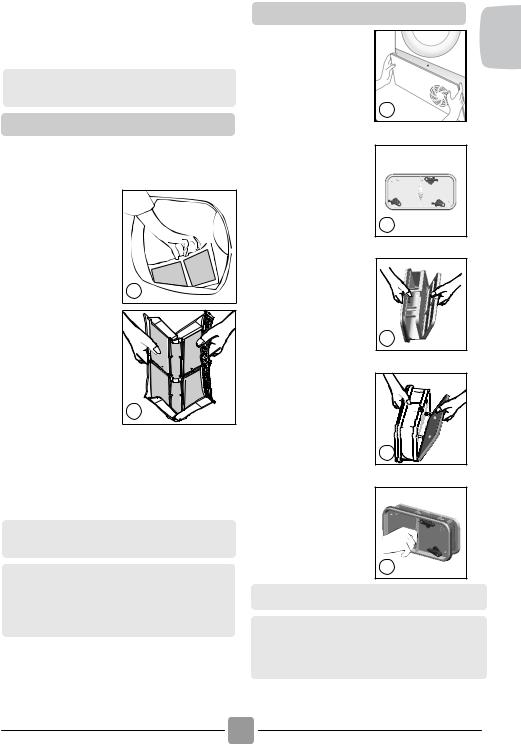
6. DOOR and FILTER
Pull on handle to open the door.
To restart the dryer, close the door and press Start / Pause button. 
 WARNING! When the tumble dryer is in use the drum and door may be VERY HOT.
WARNING! When the tumble dryer is in use the drum and door may be VERY HOT.
Filter
IMPORTANT: To maintain the efficiency of the dryer check that the fluff filter is clean before each drying cycle.
1.P u l l t h e f i l t e r upwards.
2.Open filter as shown.
3.Gently remove lint using a soft brush or your fingertips.
4.S n a p t h e f i l t e r together and push back into place.
1 |
2
Filter Care Indicator
 Lights when the filter needs cleaning.
Lights when the filter needs cleaning.
If the laundry is not drying check that the filter is not clogged.
 IF YOU CLEAN FILTER UNDER WATER, REMEMBER TO DRY IT.
IF YOU CLEAN FILTER UNDER WATER, REMEMBER TO DRY IT.
 WARNING! If you open the door mid cycle, before the cool-down cycle has completed,the handle may be hot. Please use extreme caution when attempting to empty the water reservoir during the cycle.
WARNING! If you open the door mid cycle, before the cool-down cycle has completed,the handle may be hot. Please use extreme caution when attempting to empty the water reservoir during the cycle.
To Clean the Condenser Filter
EN
1. R e m o v e t h e kickplate.
2.Turn the two locking levers anti-clockwise and pull out the front cover.
3.Gently remove the filter frame and clean any dust or fluff with a cloth from the filter. Do not use water to clean the filter.
4.Remove the sponge gently from its place and then wash the sponge by holding it under a running tap turning it so to remove any dust or fluff.
5.Refit the front cover
ensuring it is in the c o r r e c t w a y ( a s indicated by the arrow) and pushed firmly into place. Lock the two levers by turning them clockwise
6. Refit the kickplate.
1
2
3
4 |
5
 Clean the filters before every cycle
Clean the filters before every cycle
 Please pay attention that overloading or bulky load can lead to door opening, in this case please reduce the load capacity to continue the drying cycle.
Please pay attention that overloading or bulky load can lead to door opening, in this case please reduce the load capacity to continue the drying cycle.
11
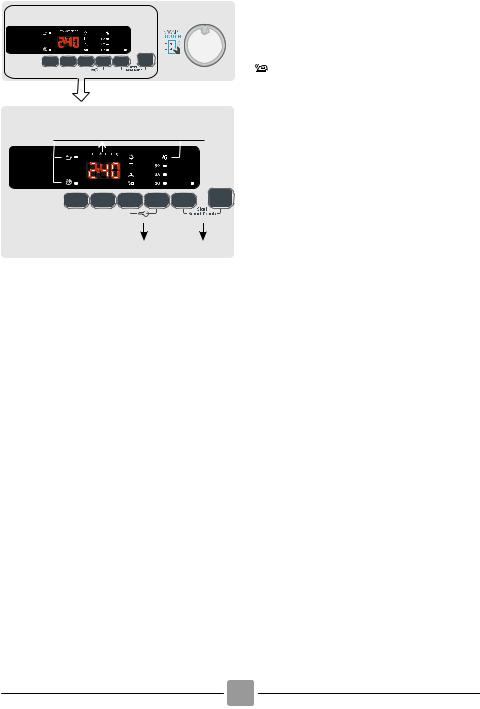
7.CONTROLS AND INDICATORS
A
E
B
D
C
2 |
3 |
4 |
5 |
6 |
1 |
|
|
|
7 |
|
8 |
A-Programme Selector - Rotating the knob in both directions it's possible to select the desired drying program. To cancel the selections or switch off the dryer rotate the knob on OFF.
B- Display Digit - The display shows the remaining time for drying, the postponed time in case of delayed start selection and other notifications setting.
C-Buttons -
1.Start/Pause Button
To start the selected program and/or suspend it.
2.Time cycle selection
It's possible transform a cycle from automatic to programmed, up to 3 minutes after the start of the cycle. The progressive pressure increases the time in 10-minute intervals.
After this selection to reset the automatic dying functioning is necessary to switch off the dryer In case of incompatibility, all LEDs flash quickly for 3 times.
3.Delay Start Button
It allows to delay the start of the program from 1 to 24 hours in 1-hour intervals. The delay selected is shown on the display.
After pressing the START button the time showed decrease hour after hour.
Opening of the porthole with delayed start set, after re-closing the porthole, press start again to resume the counting.
4.Drying Selection Button
It allows to set the desired dryness level editable option up to 5 minutes after the starting of the cycle:
- Ready to Iron : It leaves the garments slightly wet to facilitate ironing.
 - Dry Hanger : To get garment ready to be hang
- Dry Hanger : To get garment ready to be hang
 - Dry wardrobe : For laundry that can be directly stored
- Dry wardrobe : For laundry that can be directly stored
 -Extra-dry : To get completely dry garments, ideal for full load.
-Extra-dry : To get completely dry garments, ideal for full load.
This appliances is equipped with Drying Manager Function. On automatic cycles, each level of intermediate drying, prior to the reaching the selected one, is indicated by flashing the light indicator corresponding to the degree of drying reached In case of incompatibility, all LEDs flash quickly for 3 times.
5.Rapids Button
It's possible switch an automatic program to RAPID program, up to 3 minutes after the start of the cycle. The progressive pressure increases the time (30-45-59 minutes).
After this selection to reset the automatic dying functioning is necessary to switch off the dryer In case of incompatibility, all LEDs flash quickly for 3 times.
6.Anti crease
This option allows to activate an anti-creases movement of the drum pre cycle in case of activation of the delay and at the end of drying cycle. It is activated every 10 minutes, up to 6 hours after the end of the drying cycle. To stop the movements set the knob to OFF.
Useful when it's not possible to remove immediately.
7. Keylock
This function allows to block unwanted changes of the set options on the bezel , during drying phase.
Activation/ Inactivation: Push 4 and 5 buttons simultaneously for two seconds . The sign "LOC" appears on the display. Unlocking the option, on the display appears the sign "Unl", only once. In case of opening of 'porthole' with activated key lock, the cycle stops but the lock is kept: to restart the cycle, you must remove the lock and restore Start. When the dryer is off, the option is automatically inactivated.
Key lock can be modified at any time of the cycle.
12
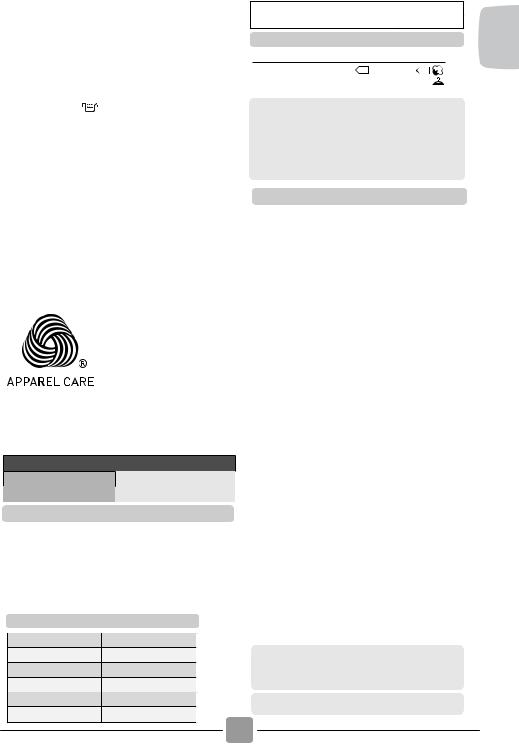
8.Start smart touch
Simultaneously pressing the START/PAUSE and
OPTIONS buttons allows a previously downloaded cycle to be started whilst the Smart Touch position is selected on the programme knob (for downloading cycles from the App see the relevant section of this user manual).
D- Led
Water tank |
- It lights up when it's |
necessary to empty the condensate water tank.
Filter cleaning  - It lights up when the cleaning of the filters is requested (the door and the lower filter.)
- It lights up when the cleaning of the filters is requested (the door and the lower filter.)
Cooling  - It lights up when the cycle is in the final cooling phase.
- It lights up when the cycle is in the final cooling phase.
E-
SMART TOUCH area - pressing the START/PAUSE button allows to a previously downloaded cycle to start whilst the Touch position is selected on the programme knob (for downloading cycles from the App see the relevant section of this user manual).
The wool drying cycle of this m a c h i n e h a s b e e n approved by The Woolmark Company for the drying of machine washable wool products provided that the products are washed and
dried according to the instructions on the garment label and those issues by the manufacturer of this machine. M1530. In UK, Eire, Hong Kong and India the Woolmark trade mark is a Certification trade mark.
Maximum Drying Weight
Cottons |
Max.capacity declared |
Synthetics or Delicates |
Max.4 Kg |
Drying Guide
The standard cycle COTTON DRY (  ) is the most energy efficient and best suited for drying normal wet cotton laundry. The table in last page shows the approximate time and energy consumption of the main drying programmes.
) is the most energy efficient and best suited for drying normal wet cotton laundry. The table in last page shows the approximate time and energy consumption of the main drying programmes.
Technical Specifications
Drum capacity |
78,5 |
Maximum load |
See energy label |
Height |
85 cm |
Width |
60 cm |
Depth |
48,7 cm |
Energy class |
See energy label |
Power consumption of off-mode |
0,40 W |
Power consumption of on-mode |
0,75 W |
|
|
Information for Test Laboratory
EN 61121 Programme To Use
-DRY COTTON |
- COTTON OR |
-IRON DRY COTTON |
-COTTON OR WHITES |
-EASY-CARE TEXTILE |
-DELICATES OR SYNTHETIC |
 The real duration of drying cycle depends by the starting humidity level of the laundry due to spin speed, type and amount of load, cleanliness of filters and ambient temperature.
The real duration of drying cycle depends by the starting humidity level of the laundry due to spin speed, type and amount of load, cleanliness of filters and ambient temperature.
OPERATION
1.Open the door and load the drum with laundry. Ensure that garments do not hinder closure of the door.
2.Gently close the door pushing it slowly until you hear the door 'click' shut.
3.Turn the Programme Selector dial to select the required drying programme (see Programme Guide).
4.Press the  button. The dryer will start automatically and the indicator
button. The dryer will start automatically and the indicator
above the button will be continuously lit.
5.If the door is opened during the
programme to check the laundry, it is necessary to press  to recommence drying after the door has been closed.
to recommence drying after the door has been closed.
6. W h e n t h e c y c l e i s n e a r i n g completion the machine will enter the cool down phase, the clothes will be tumbled in cool air allowing the load to cool down.
7. Following the completion of the cycle the drum will rotate intermittently to minimize creasing. This will continue until the machine is switched OFF or the door is opened.
8.When the programme is complete the END indicator will light.
 Do not open the door during the automatic programs in order to obtain a proper drying.
Do not open the door during the automatic programs in order to obtain a proper drying.
 Clean the filters before every cycle
Clean the filters before every cycle
EN
13
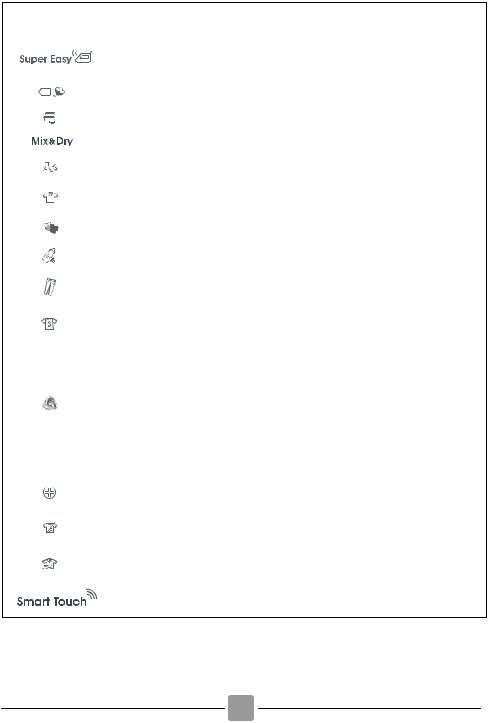
8. SELECTING THE PROGRAMME AND SET THE FUNCTION
|
|
CAPACITY |
DRYING |
PROGRAM |
PROGRAM DESCRIPTION |
(kg) |
TIME |
|
|
(min) |
|
|
A comfortable solution to dry laundry of mixed fabrics minimazing |
2 |
* |
|
folds, delivering the perfect humidity to iron in the easier way. |
||
|
Before drying it's better to shake off the linens. |
|
|
|
Program Eco normative (hang dry) drying. The most efficient |
5 |
* |
|
program in energy consumption. Suitable for cottons and linens. |
||
|
|
|
|
|
The right cycle to dry cottons, sponges and towels. |
Full |
* |
|
To dry all together different kind of fabrics as cotton ,linen, |
4 |
* |
|
mix, synthetics. |
||
|
To dry delicate and synthetic fabrics that need an accurate |
4 |
* |
|
and specific treatment. |
||
|
This specifics cycle has been conceived to dry shirts minimizing |
2.5 |
|
|
tangles and folds thanks specific movements of the drum. It's |
* |
|
|
recommended to take out the linens immediately after drying cycle. |
|
|
|
A delicate and specific cycle to dry dark or colour cotton or |
4 |
* |
|
syntethics garments. |
||
|
This cycle is perfect for baby clothes, when an high hygiene level |
4 |
150’ |
|
is expected. |
||
|
|
|
|
|
Dedicated to dry uniformly fabrics like jeans or denim. It's |
4 |
|
|
recommended flip over the garments before drying. |
* |
|
|
|
|
|
|
Dedicated to technical garments for sport and fitness, drying |
|
|
|
gently with special care to avoid shrinking and deterioration |
4 |
* |
|
of elastic fibers. |
|
|
|
|
|
|
|
Woolen clothes: the program can be used to dry up to 1 kg of |
|
|
|
laundry (around 3 jumpers). It is recommended to reverse all |
|
|
|
clothes before drying. Timing can change due to dimensions |
|
|
|
and thickness of load and to spinning chosen during |
|
|
|
washing. At the end of the cycle, clothes are ready to be |
1 |
70’ |
|
worn, but if they are heavier, edges can be a bit wet: it is |
||
|
suggested to dry them naturally. It is recommended to |
|
|
|
unload clothes at the very end of the cycle. Attention: felting |
|
|
|
process of wool is irreversible; please dry exclusively clothes |
|
|
|
with symbol (symbol "ok tumble"); this program is not |
|
|
|
indicated for acrylic clothes. |
|
|
|
|
|
|
|
One specifics cycle that dry and in the same time helps to |
4 |
220’ |
|
reduce the main allergens as dustmites, pet hair, pollens and |
||
|
residual of powder detergents. |
|
|
|
This is a warm cycle that in only 12 minutes helps to relaxe folds |
2.5 |
12’ |
|
and creases. |
||
|
|
|
|
|
The perfect cycle to remove the bad smells from the linens |
2.5 |
* |
|
smoothing creases. |
||
|
|
|
|
Customizable setting that interacts with the App on your android smartphone and to download the cycles (see the dedicated section). The factory sets the default programme Auto-Hygiene, which will sanitize the machine.
* The real duration of drying cycle depends by the starting humidity level of the laundry due to spin speed, type and amount of load, cleanliness of filters and ambient temperature.
14

SMART TOUCH
This appliance is equipped with Smart Touch technology that allows you to interact, via the App, with smartphones based on Android operating system and equipped with NFC (Near Field Communication) function.
● Download on your smartphone the Candy simply-Fi App.
The Candy simply-Fi App is available for devices running both Android and iOS, both for tablets and for smartphones. However, you can interact with the machine and take advantage of the potential offered by Smart Touch only with Android smartphones equipped with NFC technology, according to following functional scheme:
Android smartphone |
Interaction with the |
with NFC technology |
machine + contents |
|
|
Android smartphone |
Contents only |
without NFC technology |
|
|
|
Android Tablet |
Contents only |
Apple iPhone |
Contents only |
Apple iPad |
Contents only |
|
|
FUNCTIONS
The main functions available using the App are:
●Voice Assistant – A guide to help you choose the ideal cycle with only three voice inputs (clothes/fabrics, colour, drying level).
●Cycles – To download and launch new drying programmes.
●Smart Care – -Smart Check-up and a troubleshooting guide.
●My Statistics – Drying statistics and tips for a more efficient use of your machine.
Get all the details of the Smart Touch functions, browsing the App in DEMO mode or go to: www.candysmarttouch.com
HOW TO USE SMART TOUCH
FIRST TIME - Machine registration
Enter the "Settings" menu of your Android smartphone and activate the NFC function inside the "Wireless & Networks" menu.
Depending on the smartphone model and its Android OS version, the process of the NFC activation may be different. Refer to the smartphone manual for more details.
● Turn the knob to the Smart Touch position to enable the sensor on the dashboard.
● Open the App, create the user profile and register the appliance following the instructions on the phone display or the "Quick Guide" attached on the machine.
More information, F.A.Q. and the video for an easy registration are available on: www.candysmarttouch.com/how-to
EN
15
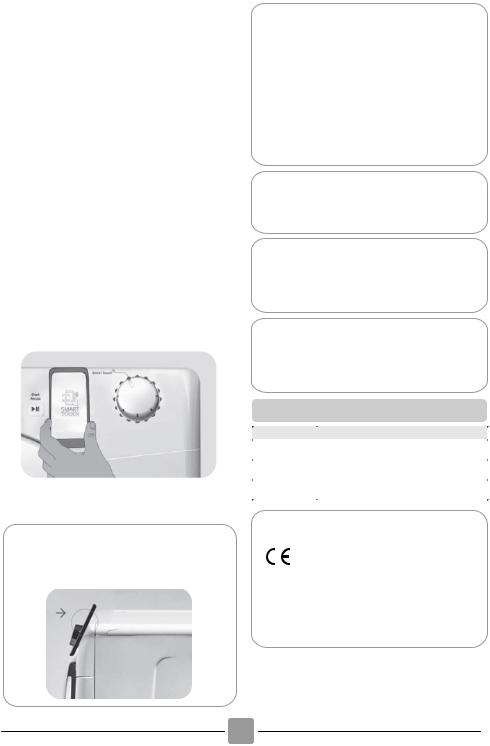
NEXT TIME – Regular usage
●Every time you want to manage the machine through the App, first you have to enable the Smart Touch mode by turning the knob to the Smart Touch indicator.
●Make sure you have unlocked your phone (from stand-by mode) and you have activated the NFC function; then, follow the
steps mentioned earlier.
●If you want to start a dry cycle, load the laundry and close the door.
●Select the desired function in the App (e.g.: starting a programme, the Smart Check- up cycle, update statistics, etc…).
●Follow the instructions on the phone display, KEEPING IT ON the Smart Touch logo on the machine dashboard, when requested to do so by the App.
If you do not know the position of your NFC antenna, slightly move the smartphone in a circular motion over the Smart Touch logo until the App confirms the connection. In order for the data transfer to be successful, it is essential TO KEEP THE SMARTPHONE ON THE DASHBOARD DURING THESE THE FEW SECONDS OF THE PROCEDURE; a message on the device will inform about the correct outcome of the operation and advise you when it is possible to move the smartphone away.
Thick cases or metallic stickers on your smartphone could affect or prevent the transmission of data between machine and telephone. If necessary, remove them.
The replacement of some components of the smartphone (e.g. back cover, battery, etc...) with non-original ones, could result in the NFC antenna removal, preventing the full use of the App.
The management and the control of the machine via App is only possible "by proximity": it is therefore not possible to perform remote operations (e.g.: from another room; outside of the house).
WIRELESS PARAMETERS
Parameter |
Specifications |
|
|
Wireless Standard |
ISO/IEC 14443 Type A and NFC Forum Type 4 |
|
|
Frequency band |
13,553-13,567 MHz (centre frequency 13,560 MHz) |
|
|
Magnetic field limit |
< 42dBμA/m (at 10 meters) |
|
|
NOTES:
Place your smartphone so that the NFC antenna on its back matches the position of the Smart Touch logo on the appliance (as illustrate below).
With this the Candy Hoover Group Srl,
declares that this appliance marked with
complies with the essential
requirements of the Directive 2014/53/EU. To receive a copy of the declaration of
c o n f o r m i t y, p l e a s e c o n t a c t t h e
manufacturer at: www.candy-group.com
16

9. TROUBLESHOOTING
FOR SMART TOUCH MODELS
The Candy simply-Fi app has a Smart Check-up function that allows you to confirm the functionality and status of the product at any time. To use the Candy simply-Fi APP you will need an Android smartphone with NFC technology.
More info can be found on the App.
If the display of the machine is showing an error (by a code or blinking LEDs), you should turn on the App on your Android smartphone, with NFC on, selecting "Read the error" on the "Help on line" menu place your smart phone against the Smart Touch logo on the control panel. You should now be able to read the fault directory to solve the issue.
What Might be the Cause of...
Defects you can remedy yourself
Before calling service for technical advice please run through the following checklist. A charge will be made if the machine is found to be working or has been installed incorrectly or used incorrectly.
If the problem persists after completing the recommended checks, please call Service, they may be able to assist you over the telephone.
Time display to end could change during drying cycle. The time to end is continuously checked during the drying cycle and the time is adjusted to give the best estimation time. The displayed time may increase or decrease during the cycle and this is normal.
Drying time is too long/clothes are not dry enough…
●Have you selected the correct drying time/programme?
●Were the clothes too wet? Were the clothes thoroughly wrung or spindried?
●Does the filter need cleaning?
●Is the dryer overloaded?
The dryer does not operate…
●Is there a working electricity supply to the dryer? Check using another appliance such as a table lamp.
●Is the plug properly connected to the mains supply?
●Is there a power failure?
●Has the fuse blown?
●Is the door fully closed?
●Is the dryer switched on, both at the mains supply and at the machine?
●Has the drying time or the programme been selected?
●Has the machine been switched on again after opening the door?
The dryer is noisy…
●Switch off the dryer and contact GIAS
Service for advice.
The  Indicator is on…
Indicator is on…
●Does the filter need cleaning?
The  Indicator is on…
Indicator is on…
● Does the water container need emptying?
CUSTOMER SERVICE
Should there still be a problem with your d r y e r a f t e r c o m p l e t i n g a l l t h e recommended checks, please call service for advice.
They may be able to assist you over the telephone or arrange for a suitable appointment for an engineer to call under the terms of your guarantee. However, a charge may be made if any of the following applies to your machine:
●Is found to be in working order.
●Has not been installed in accordance with the installation instructions.
●Has been used incorrectly.
Spares
Always use genuine spares, available direct from service.
Service
For service and repairs call your local service engineer.
The manufacturer declines all responsibility in the event of any printing mistakes in this booklet. The manufacturer also reserves the right to make appropriate modifications to its products without changing the essential characteristics.
EN
17

Veuillez lire et suivre ces instructions avec soin et utiliser la machine en conséquence. Ce livret contient des instructions importantes sur la sécurité d'utilisation, l'installation et l'entretien de la machine, ainsi que des conseils utiles pour obtenir les meilleurs résultats possibles lors de son utilisation. Conservez toute la documentation dans un endroit sûr pour pouvoir vous y reporter à une date ultérieure ou la transmettre aux prochains propriétaires
Vérifiez que les articles suivants ont bien été livrés avec l’appareil :
●Manuel d'utilisation
●Carte de garantie
●Étiquette d'énergie
En utilisant le symbole 
 sur ce produit, n o u s d é c l a r o n s s u r n o t r e p r o p r e responsabilité que ce produit est conforme à toutes les normes européennes relatives à la sécurité, la santé et à l'environnement.
sur ce produit, n o u s d é c l a r o n s s u r n o t r e p r o p r e responsabilité que ce produit est conforme à toutes les normes européennes relatives à la sécurité, la santé et à l'environnement.
 Vérifiez que la machine ne s'est pas détériorée en transit. Si c'est le cas, contactez GIAS pour une opération de dépannage. Le non-respect de ces instructions peut compromettre la sécurité de votre appareil. Un appel de service peut vous être facturé si la défaillance de votre appareil est causée par une mauvaise utilisation.
Vérifiez que la machine ne s'est pas détériorée en transit. Si c'est le cas, contactez GIAS pour une opération de dépannage. Le non-respect de ces instructions peut compromettre la sécurité de votre appareil. Un appel de service peut vous être facturé si la défaillance de votre appareil est causée par une mauvaise utilisation.
Index
1.RAPPELS DE SÉCURITÉ
2.KIT TUYAU D'ÉVACUATION: INSTRUCTIONS DE MONTAGE
3.PRÉPARATION DE LA CHARGE
4.NETTOYAGE ET ENTRETIEN DE ROUTINE
5.RÉSERVOIR D’EAU
6.PORTE ET FILTRE
7.COMMANDES ET INDICATEURS
8.SÉLECTION DU PROGRAMME
9.DÉPISTAGE DE PANNES & SERVICE CLIENTÈLE
18

1.RAPPELS DE SÉCURITÉ
●Cet appareil peut être utilisé par des enfants âgés de 8 ans et
plus, ou des personnes p r é s e n t a n t u n h a n d i c a p physique, moteur ou mental, et manquant de connaissance sur l’utilisation de l’appareil, si elles sont sous la surveillance d’une p e r s o n n e , d o n n a n t d e s instructions pour une utilisation en toute sécurité de l’appareil.
Les enfants ne doivent pas jouer avec l'appareil.
Le nettoyage et l’entretien de l’appareil ne doit pas être fait p a r d e s e n f a n t s s a n s surveillance d’un adulte.
●ATTENTION La mauvaise utilisation d’ un sèche-linge risque de causer un incendie.
●Le produit est conçu pour être
u t i l i s é d a n s u n f o y e r domestique, comme - Le coin cuisine dans des magasins ou des lieux de travail,
-Employés et clients dans un hôtel, un motel ou résidence de ce type,
-Dans des bed and breakfast,
-Service de stock ou similaire, mais pas pour de la vente au détail.
La durée de vie de l’appareil peut être réduite ou la garantie du fabricant annulée si l’appareil n’est pas utilisé correctement.
Tout dommage ou perte résultant d'un usage qui n'est pas conforme à un usage
domestique (même s'ils sont s i t u é s d a n s u n environnement domestique ou un ménage) ne sera pas acceptée par le fabricant dans toute la mesure permise par la loi.
●Cette machine est conçue uniquement pour usage domestique, à savoir pour sécher le linge domestique et les vêtements.
●Cette machine ne doit être utilisée que pour l’ emploi auquel elle est destinée et qui est décrit dans ce manuel.
Assurez-vous d'avoir bien compris les instructions d'installation et d'utilisation avant de faire fonctionner la machine.
●Ne touchez pas la machine si vous avez les mains ou les pieds mouillés ou humides.
●Ne vous appuyez pas sur la porte lorsque vous chargez la machine et n'utilisez pas la porte pour soulever ou déplacer la machine.
●Ne laissez pas des enfants jouer avec la machine ou avec ses commandes.
●ATTENTION N’ utilisez pas cette machine si le filtre à peluches n’ est pas en place ou s’ il est endommagé ; les peluches risquent en effet de s'enflammer.
FR
19
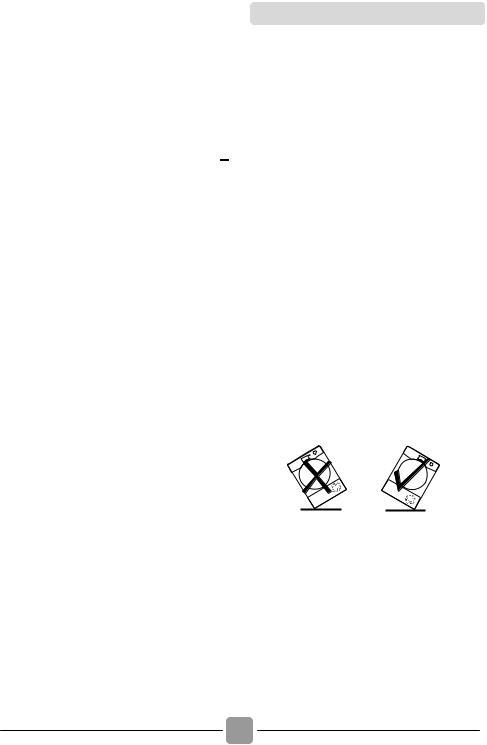
●ATTENTION L’augmentation de t e m p é r a t u r e p e n d a n t l e fonctionnement du sèche-linge peut être supérieure à 60°C là où se trouve le symbole de surface chaude .
●Débranchez le courant du
secteur. Retirez toujours la prise avant de nettoyer la machine.
●Cessez d’utiliser la machine si elle semble défectueuse.
●Veillez à ce que les peluches ne puissent pas s’accumuler sur le sol, à l’extérieur de la machine.
●Il se peut que l’intérieur du tambour soit très chaud. Veillez à ce que le sèche-linge termine son cycle de refroidissement avant d’en sortir le linge.
●La dernière partie du cycle s'effectue à froid (cycle de refroidissement)pour garantir la préservation des textiles.
●AVERTISSEMENT: Le sèchelinge ne doit pas être utilisé si le lavage a été effectué avec des produits chimiques.
●AVERTISSEMENT: Ne jamais arrêter le sèche-linge avant la fin du cycle de séchage à condition que les éléments sont retirés rapidement et répartis de telle sorte que la chaleur puisse se dissiper.
Installez l'arrière de l'appareil près d'un mur ou d'une surface verticale.
●Charge maximum pour le séchage:Se reporter à l'étiquette énergétique.
Installation
●N'utilisez pas d'adaptateurs, de multi-prises et/ou de rallonges.
●Veillez à ne pas installer le sèche-linge contre des rideaux et assurez-vous que rien ne puisse tomber ou s’accumuler derrière le sèche-linge.
●Cet appareil ne doit pas être
installé derrière une porte v e r r o u i l l a b l e , u n e p o r t e coulissante ou une porté munie de gonds placée en face de la porte du sèche-linge.
Important : Pendant le transport, l’appareil doit être stocké dans sa position normale d’utilisation. Si nécessaire, l’appareil peut être incliné comme montré ci-dessous.
Attention : Si le produit est t r a n s p o r t é d i ff é r e m m e n t , attendez au moins 4 heures avant d’allumer l’appareil, ceci afin que le gaz liquide retourne dans le compresseur. En cas de non respect de cette procédure, le compresseur pourrait être endommagé
20

Le Linge
●Ne séchez pas des vêtements non lavés dans le sèche-linge.
●ATTENTION NE séchez PAS les tissus qui ont été traités avec des liquides de nettoyage à sec.
● ATTENTION |
Quand |
elles sont |
|
c h a u f f é e s , l e s m o u s s e s |
|||
alvéolaires peuvent dans certains |
|||
cas brûler |
par |
combustion |
|
spontanée Les articles en mousse |
|||
caoutchouc (mousse de latex), les |
|||
bonnets de douche, le textile |
|||
imperméable, |
les |
articles |
|
caoutchoutés et les vêtements ou |
|||
coussins rembourrés de mousse |
|||
caoutchouc |
NE DOIVENT PAS |
||
être séchés dans le sèche-linge.
●Reportez-vous toujours aux étiquettes d’entretien du linge pour vérifier le mode de séchage recommandé.
●Les vêtements doivent être essorés en machine ou à la main avant d’être placés dans le sèchelinge. Les vêtements qui dégoulinent NE DOIVENT PAS être mis dans le sèche-linge.
●Enlevez les briquets et les allumettes des poches et veillez à ne JAMAIS utiliser des liquides inflammables à proximité de la machine.
●Les rideaux en fibres de verre ne doivent JAMAIS être placés dans cette machine. La contamination d’autres vêtements par les fibres de verre peut entraîner des irritations de la peau.
●Les articles qui ont été souillés par des substances telles que huile de cuisson, acétone, alcool, pétrole, kérosène, produit anti-taches, térébenthine, cire et décapant pour
cire doivent être lavés à l'eau chaude avec une quantité supplémentaire de détergent avant d'être séchés dans le sèche-linge.
●Les agents adoucissants, et autres produits similaires, d o i v e n t ê t r e u t i l i s é s conformément aux instructions fournies par le fabricant du produit.
Ventilation
●La pièce où se trouve le sèchelinge doit avoir une ventilation adéquate de manière à ce que les gaz des appareils qui brûlent d’autres combustibles, y compris les cheminées, ne soient pas attirés dans la pièce pendant que le sèche-linge est en marche
●Installez l'arrière de l'appareil près d'un mur ou d'une surface verticale.
●Il doit y avoir un espace minimum de 12 mm entre la machine et quelconque obstacle. L'entrée et la sortie d'air doivent être dégagées. Pour assurer une ventilation adéquate, l'espace entre le bas de la machine et le sol ne doit pas être obstrué.
●L’ air d’ échappement ne doit
pas être évacué par un conduit qui est également utilisé pour é v a c u e r l e s f u m é e s d’échappement d’appareils qui brûlent du gaz ou d’autres combustibles.
FR
21
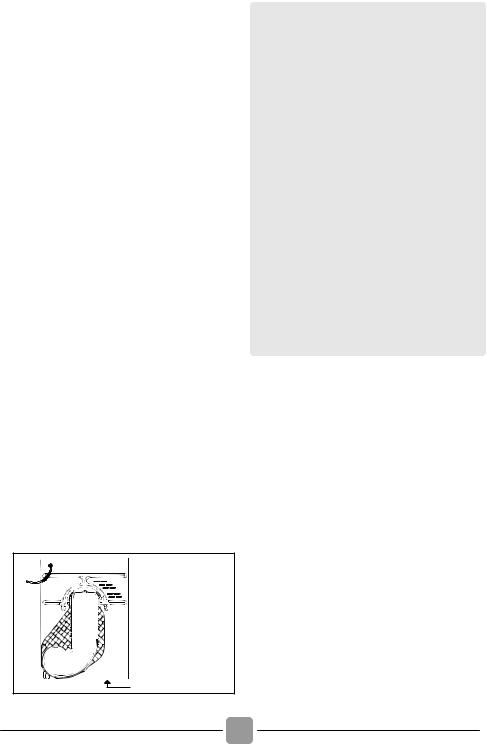
●Vérifiez régulièrement que l’ air peut circuler librement autour du sèche-linge.
●Contrôlez régulièrement le filtre à peluches après usage et nettoyez-le si nécessaire.
●Veillez à ce que rien ne puisse tomber ou s’accumuler entre les côtés et l’arrière du sèche-linge afin de ne pas obstruer l'entrée et la sortie d’air.
●N’ installez JAMAIS le sèchelinge contre des rideaux.
●Dans le cas ou le sèche-linge est positionné en colonne au dessus d'une machine à laver, un kit de superposition approprié doit être utilisé, selon la configuration suivante.
Kit Mod 35100019: pour un lave linge avec une profondeur min. 49 cm
Kit Mod 35900120: pour un lave linge avec une profondeur min.
51 cm
Le kit de superposition est disponible auprès du service p i è c e s d é t a c h é e s . L e s instructions pour l'installation de l'appareil et de ses accessoires sont fournis avec le kit.
 Ne pas installer le produit dans une pièce à la température basse où le risque de formation de glace est possible. A la température de congélation de l'eau, le produit risque de ne pas fonctionner correctement. Si l'eau du circuit hydraulique se glace, les composants suivants risquent d'être endommagés : soupape, pompe, tubes. Afin de garantir les meilleures performances du produit, la température de la pièce doit être comprise entre
Ne pas installer le produit dans une pièce à la température basse où le risque de formation de glace est possible. A la température de congélation de l'eau, le produit risque de ne pas fonctionner correctement. Si l'eau du circuit hydraulique se glace, les composants suivants risquent d'être endommagés : soupape, pompe, tubes. Afin de garantir les meilleures performances du produit, la température de la pièce doit être comprise entre
+2°C et +35°C. Veuillez noter que l'utilisation à des températures basses (entre 2° et 15°C) peut entraîner une condensation de l'eau et des gouttes sur le sol.
Air Outlets in the Base
22
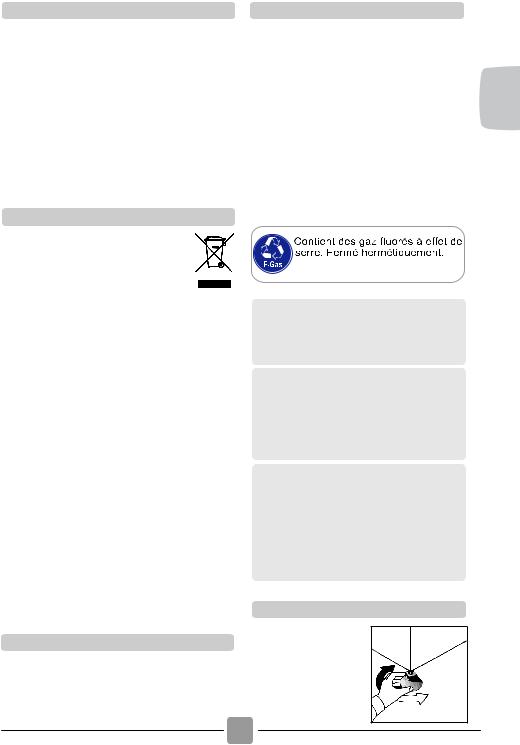
Protection de l'environnement
●Tous les matériaux de conditionnement utilisés sont écologiques et recyclables. Veuillez les éliminer de manière écologique. Votre municipalité pourra vous donner le détail exact des méthodes d’élimination en vigueur.
●Pour assurer la sécurité lors de l’élimination d’un vieux sèche-linge, veuillez débrancher la fiche du courant de secteur, couper le câble d’alimentation et le détruire avec la fiche. Pour empêcher que les enfants ne s’enfer-ment dans la machine, cassez les charnières de la porte ou son dispositif de verrouillage.
Directive européenne 2012/19/CE
Cet appareil est commercialisé en accord avec la directive européenne 2012/19/CE sur les déchets des équipements électriques et électroniques (DEEE).
Les déchets des équipements électriques et électroniques (DEEE) contiennent des substances polluantes (ce qui peut entraîner des conséquences négatives pour l'environnement) et des composants de base (qui peuvent être réutilisés). Il est important de traiter ce type de déchets de manière appropriée afin de pouvoir éliminer correctement tous les polluants et de recycler les matériaux.
Les particuliers peuvent jouer un rôle important en veillant à ce que les DEEE ne d e v i e n n e n t p a s u n p r o b l è m e environnemental. Il est essentiel de suivre quelques règles simples :
-Les DEEE ne doivent pas être traités comme les déchets ménagers.
-Les DEEE doivent être remis aux points de collecte enregistrés. Dans de nombreux pays, la collecte des produits gros électroménagers peut être effectuée à domicile.
Dans de nombreux pays, lorsque vous achetez un nouvel appareil, l'ancien peut être retourné au détaillant qui doit collecter gratuitement sur la base un contre un. L'équipement repris doit être équivalent ou bien avoir les mêmes fonctions que le produit acquis.
Service GIAS
● Pour veiller au fonctionnement efficace et sans r i s q u e d e c e t a p p a r e i l , n o u s v o u s recommandons de faire exclusivement appel à un technicien GIAS agréé pour son entretien ou sa réparation éventuelle.
Besoins Électriques
Les sèche-linges sont prévus pour une tension monophasée de 220-240 V, 50 Hz. Vérifiez que la tension nominale du circuit d'alimentation est réglée sur 6 A minimum.
L’électricité peut être extrêmement dangereuse.
Cet appareil doit être mis à la terre. La prise de courant et la fiche de la machine doivent être du même type. N'utilisez pas de multi-prises et/ou de rallonges.
La fiche doit être accessible pour débrancher l’appareil une fois qu’il a été installé.
 GWP1430
GWP1430
 Vous pourrez être facturé en cas d'appel du service après vente si le problème sur le sèche-linge est causé par une mauvaise installation.
Vous pourrez être facturé en cas d'appel du service après vente si le problème sur le sèche-linge est causé par une mauvaise installation.
 Si le câble électrique de l'appareil est endommagé, il doit être remplacé par un câble spécifique, qui peut être obtenu UNIQUEMENT via le service des pièces détachées. Il doit être installé par une personne compétente.
Si le câble électrique de l'appareil est endommagé, il doit être remplacé par un câble spécifique, qui peut être obtenu UNIQUEMENT via le service des pièces détachées. Il doit être installé par une personne compétente.
 Ne branchez pas la machine et ne l'allumez pas avant que l'installation soit entièrement effectuée. Pour votre sécurité, le sèche-linge doit être correctement installé. Si vous avez un doute quelconque sur l'installation, appeler le service GIAS qui sera apte à vous conseiller.
Ne branchez pas la machine et ne l'allumez pas avant que l'installation soit entièrement effectuée. Pour votre sécurité, le sèche-linge doit être correctement installé. Si vous avez un doute quelconque sur l'installation, appeler le service GIAS qui sera apte à vous conseiller.
Ajustement Des Pieds
Lorsque la machine est en place, les pieds doivent être ajustés pour mettre la machine de niveau.
FR
23
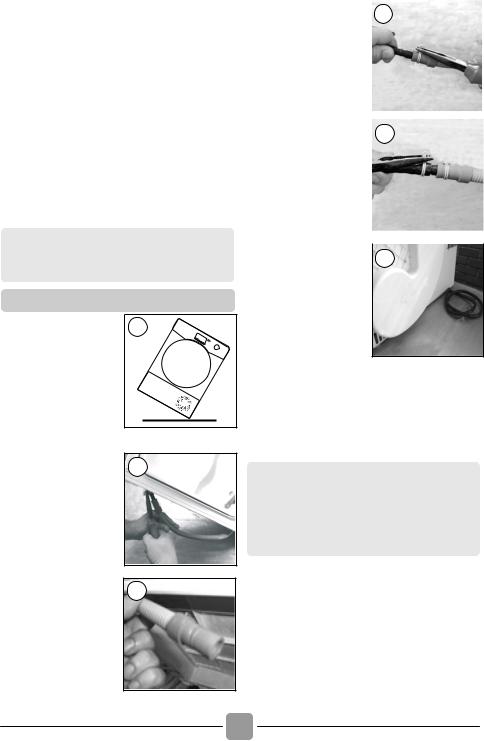
2. KIT TUYAU D'ÉVACUATION:
INSTRUCTIONS DE MONTAGE
Afin d'éviter d'avoir à vider le réservoir d'eau après chaque cycle de séchage, l'eau qui est normalement recueillie dans ce même réservoir pendant le cycle le séchage peut être évacuée directement par un tuyau d'évacuation d'eaux usées (le même système de vidange que celui des éviers domestiques).
Les arrêtés municipaux en matière d'évacuation d'eau interdisent la connexion à un égout d'eau de surface. Le système de vidange d'eaux sales doit être placé à proximité du sèche-linge.
Le Kit contient : 1 tuyau et 1 étrier de tuyau.
 ATTENTION ! Avant d'entreprendre tout travail, éteignez le sèche-linge et retirez la prise de l'alimentation électrique secteur.
ATTENTION ! Avant d'entreprendre tout travail, éteignez le sèche-linge et retirez la prise de l'alimentation électrique secteur.
Installez le Kit Suivant les Instructions:
1. Inclinez lentement l’appareil sur le côté droit.
2 . L e t u y a u d’évacuation d'eau sale se trouve du côté droit de la machine (voir ci contre). Un tuyau gris est branché sur le raccord sur le côté gauche. A l'aide d'une pince, retirez l'étrier de fixation du tuyau de raccord.
1 |
2
4. Attach |
the black |
4 |
|||
hose |
from |
the |
kit, |
||
(using |
the |
connector |
|
||
a n d p i p e c l i p s |
|
||||
supplied), to the hose |
|
||||
removed |
from |
the |
|
||
bridge connection. |
|
|
|||
|
|
||||
|
|
|
|
|
|
5. Une fois la machine |
5 |
||||
en place, ajustez les |
|
||||
pieds de façon à ce |
|
||||
que le tuyau de se |
|
||||
coince |
pas |
sous |
la |
|
|
machine. |
|
|
|
|
|
|
|
|
|
||
|
|
|
|
|
|
6.Placez |
le |
robinet |
6 |
||
fourni dans le kit pour |
|
||||
fermer le tuyau. |
|
|
|||
Connectez le nouveau tuyau d'évacuation au tuyau d'eau sales.
Attention : Si le produit est transporté différemment, attendez au moins 4 heures avant d’allumer l’appareil, ceci afin que le gaz liquide retourne dans le compresseur. En cas de non respect de cette procédure, le compresseur pourrait être endommagé.
3. Retirez le tuyau du 3 raccord.
24

3. PRÉPARATION DE LA CHARGE
Avant d’utiliser le sèche-linge pour la première fois :
●Veuillez lire ce manuel d’instruction en détail.
●Retirez tous les articles qui se trouvent à l’intérieur du tambour.
●Essuyez l’intérieur du tambour et de la porte avec un chiffon humide pour éliminer la poussière éventuelle qui aurait pu s’y infiltrer en transit.
Préparation des vêtements
Vérifiez sur les étiquettes comportant les symboles d’entretien que le linge que vous souhaitez sécher convient au séchage en machine.
Vérifiez que toutes les fermetures sont fermées et que les poches sont vides. Mettez les articles à l’envers. Placez les vêtements en vrac dans le tambour en veillant à ce qu’ils ne s’emmêlent pas les uns avec les autres.
Ne séchez pas en machine :
Soie, nylon, broderies délicates, textiles avec fibres métalliques, textiles avec PVC ou bandes de cuir.
 IMPORTANT: ne séchez pas de textiles qui ont été traités avec un produit de nettoyage à sec ou contenant du caoutchouc (risque de départ de feu ou d'explosion)
IMPORTANT: ne séchez pas de textiles qui ont été traités avec un produit de nettoyage à sec ou contenant du caoutchouc (risque de départ de feu ou d'explosion)
Durant les 15 dernière minutes du cycle, l'air injecté à l'intérieur du tambour est toujours frais.
Économie d'énergie
Ne mettez que du linge essoré en machine ou à la main dans le sèche-linge. Plus le linge est sec, plus le temps de séchage sera court, ce qui économisera de l’énergie.
TOUJOURS
Convient pour séchage en machine.
. . Séchage à haute température.
.Séchage à basse température uniquement.
Ne pas sécher pas en machine.
Si le vêtement ne comporte aucune étiquette de conseils de lavage, considérez qu'il ne convient pas pour le séchage en machine.
●Par quantité et épaisseur
Lorsque la charge est plus importante que la capacité du sèche-linge, séparez les vêtements selon leur épaisseur (ex : des serviettes, des sous-vêtements fins).
●Par type de tissu
Coton/toile de lin : Serviettes, jersey en coton, linge de lit ou de table. Synthétiques : Chemisiers, chemises, blouses etc.
en polyester ou polyamide, ainsi que pour les mélanges de coton/synthétique.
●Par degré de séchage
Triez selon : sec pour repassage, sec pour rangement, etc. Pour les articles délicats, appuyez sur le bouton Séchage Délicat p o u r s é l e c t i o n n e r u n e température de séchage basse.
 Ne surchargez pas le tambour ; lorsqu’ils sont mouillés, les grands articles peuvent dépasser le poids maximal admissible (ex : sacs de couchage, couettes).
Ne surchargez pas le tambour ; lorsqu’ils sont mouillés, les grands articles peuvent dépasser le poids maximal admissible (ex : sacs de couchage, couettes).
4.NETTOYAGE ET ENTRETIEN DE ROUTINE
Nettoyage du sèche-linge
●Essayez de sécher le poids de linge maximum pour économiser du temps et de l’électricité.
●Vérifiez que le filtre est propre avant chaque cycle de séchage.
JAMAIS
●Ne dépassez pas le poids maximum pour ne pas gaspiller du temps ou de l’électricité.
●Ne mettez pas d'articles dégoulinant d’eau dans le sèche - linge pour ne pas endommager l’appareil.
Triez la charge comme suit :
●Par symbole de soin d’entretien
Vous les trouverez sur le col ou la couture intérieure :
25
●Nettoyez le filtre et videz le réservoir d’eau après chaque cycle de séchage.
●Nettoyez le condenseur à intervalles réguliers.
●Après chaque période d’utilisation, essuyez l’intérieur du tambour et laissez la porte ouverte pendant un moment pour qu’il puisse sécher grâce à la circulation d’air.
●Essuyez l’extérieur de la machine et la porte avec un chiffon doux.
●N’UTILISEZ PAS de tampons ou d’agents de nettoyage abrasifs.
FR
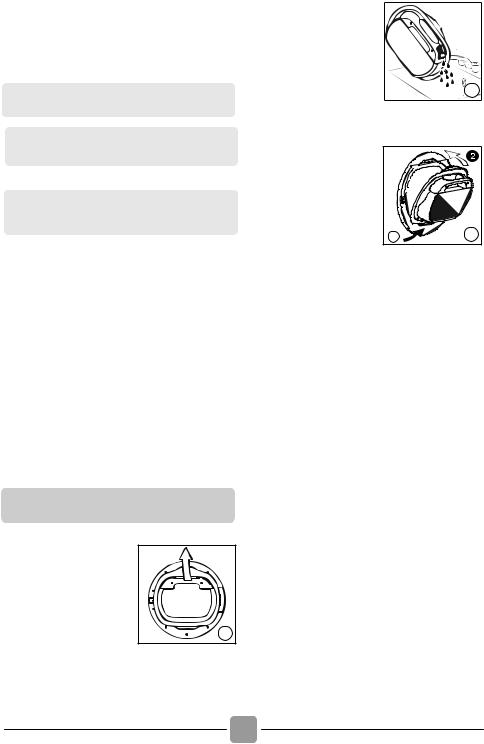
● Pour empêcher que la porte n'adhère ou que les peluches s'accumulent, nettoyez après chaque fin de cycle la surface intérieure et le joint de la porte avec un chiffon humide.
 ATTENTION! Il est possible que le tambour, la porte et la charge soient très chauds.
ATTENTION! Il est possible que le tambour, la porte et la charge soient très chauds.
 IMPORTANT: toujours éteindre et débrancher la prise avant de nettoyer l'appareil
IMPORTANT: toujours éteindre et débrancher la prise avant de nettoyer l'appareil
 Pour les données électriques, veuillez vous référer à l'étiquette de classification sur le devant de l'appareil (avec la porte ouverte)
Pour les données électriques, veuillez vous référer à l'étiquette de classification sur le devant de l'appareil (avec la porte ouverte)
5. RÉSERVOIR D’EAU
L'eau éliminée lors du cycle de séchage est collectée dans un bac à condensation situé à l'interieur de la porte du sèche-linge.
Lorsque le bac est plein , le voyant lumineux  s'allume sur le bandeau de commandes. Il signale alors qu'il faut vider le bac. Toutefois, il est conseillé de vider le bac après chaque cycle
s'allume sur le bandeau de commandes. Il signale alors qu'il faut vider le bac. Toutefois, il est conseillé de vider le bac après chaque cycle
de séchage.
NOTE : Lors des premiers cycles, lorsque le séche-linge est neuf, il n'y a que très peu d'eau qui est récupérée car le réservoir intérieur est rempli en premier.
Pour retirer le réservoir d'eau de la porte
2. Penchez le bac de récupération d'eau pour vider l'eau
Lorsque le bac est vide, le replacer comme montré; (C) commencez par insérer la base du bac dans la position montrée ( 1 ) p u i s p l a c e r doucement le dessus du bac en position (2)
3. Appuyez sur le bouton  pour redémarrer le
pour redémarrer le
cycle.
1
Note: Ne pas ouvrir la p o r t e d u r a n t l e s p r o g r a m m e s a u t o m a t i q u e s a f i n
d'obtenir |
un |
séchage |
p e r f |
o r |
m a n t |
1. Retirer doucement le bac de récupération d'eau en tenant la poignée. (A) Lorsqu'il est
p l e i n , l e b a c d e récupération d'eau pèse
environ 6 kg.
A

 B
B
C
26

6. PORTE et FILTRE
Tirez sur la poignée pour ouvrir la porte. Pour remettre le sèche-linge en marche, fermez la porte et appuyez  .
.
 Attention! Lorsque le sèche-linge est en fonctionnement la porte peut être TRES CHAUDE
Attention! Lorsque le sèche-linge est en fonctionnement la porte peut être TRES CHAUDE
Filtre
IMPORTANT: Pour garder une efficacité constante du sèche-linge, vérifiez que le filtre soit propre avant chaque cycle de séchage
Ne pas utiliser le sèche-linge sans le filtre. Un filtre encrassé peut augmenter la durée de séchage et causer des dégâts qui peuvent entraîner des coûts de réparation importants.
1. Tirez le filtre vers le haut.
2. Ouvrez le filtre, comme illustré.
1
3. Retirez doucement les peluches à l’aide d’une brosse douce ou du bout des doigts.
4. Réenclenchez le filtre et remettez-le en place.
2
Indicateur Entretien Filtre
 Vérifiez et nettoyez le filtre situé dans la porte ainsi que le condenseur situé derrière la plaque de protection, en bas du sèchelinge.
Vérifiez et nettoyez le filtre situé dans la porte ainsi que le condenseur situé derrière la plaque de protection, en bas du sèchelinge.
Si le linge n’est pas sec, vérifiez que le filtre ne soit pas encrassé.
 SI VOUS NETTOYEZ LE FILTRE SOUS L'EAU, N'OUBLIEZ PAS DE LE SECHER
SI VOUS NETTOYEZ LE FILTRE SOUS L'EAU, N'OUBLIEZ PAS DE LE SECHER
 ATTENTION! Si vous ouvrez la porte en cours de cycle, avant que le cycle de refroidissement n'ai eu lieu, la poignée peut être chaude. Veuillez faire attention en manipulant la porte et en sortant le bac de récupération d'eau pendant le cycle
ATTENTION! Si vous ouvrez la porte en cours de cycle, avant que le cycle de refroidissement n'ai eu lieu, la poignée peut être chaude. Veuillez faire attention en manipulant la porte et en sortant le bac de récupération d'eau pendant le cycle
Nettoyage du condenseur
1. Enlever la plaque de protection
2.Tourner |
les |
deux |
|
|||
leviers |
de |
blocage |
FR |
|||
d a n s l e s e n s |
||||||
c o n t r a i r e d e s 1 |
|
|||||
a i g u i l l e s d ’ u n e |
|
|||||
montre |
et |
retirer |
la |
|
||
porte. |
|
|
|
|
|
|
3. Retirez |
doucement |
|
|
|||
la poussière ou |
les |
|
|
|||
peluches |
avec |
un |
2 |
|
||
c h i ff o n . N e p a s |
|
|||||
utiliser |
d’eau |
pour |
|
|
||
n e t t o y e r |
|
l e |
|
|
||
|
|
|
||||
condenseur. |
|
|
|
|
||
4.Enlever délicatement |
|
||||
l’éponge |
de |
son |
|
||
e m p l a c e m e n t e t |
|
||||
laver l’éponge en la |
3 |
||||
passant sous un filet |
|
||||
d’eau |
afin |
d’enlever |
|
||
t o u t r e s t e d e |
|
||||
poussière |
ou |
|
de |
|
|
peluches. |
|
|
|
|
|
5 . R e m e t t e z |
|
||||
c o r r e c t e m e n t l e |
|
||||
condenseur en place |
4 |
||||
(en suivant la flèche) |
|
||||
e n l e p o u s s a n t |
|
||||
fermement. Bloquez |
|
||||
les deux leviers |
en |
|
|||
p o s i t i o n e n l e s |
|
||||
tournant |
dans |
le |
|
||
sens |
des |
aiguilles |
|
||
d’une montre. |
|
|
|
||
5
6. Remettez la plaque de protection en place.
 Limpe os filtros antes de cada ciclo
Limpe os filtros antes de cada ciclo
 Faites attention si vous surchargez la machine cela pourrait gêner la fermeturede la porte, dans ce cas réduire le chargement pour continuer le cycle de séchage
Faites attention si vous surchargez la machine cela pourrait gêner la fermeturede la porte, dans ce cas réduire le chargement pour continuer le cycle de séchage
27
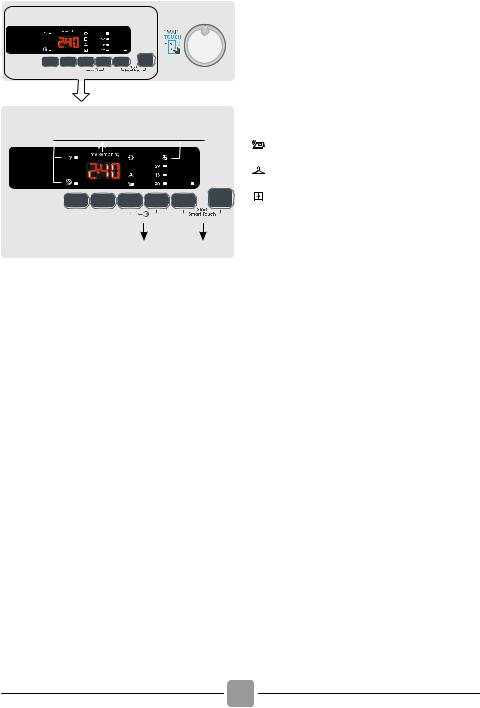
7.COMMANDES ET INDICATEURS
E
B
C
2 |
3 |
4 |
5 |
6 |
|
|
|
7 |
|
à 24 heures, par intervales de 1 heure. Le délai sélectionné est indiqué sur l'écran. Après le lancement du cycle en appuyant sur "DEMARRER", le temps restant s'affiche heure par heure. Lorsque vous ouvrez la porte du sèche-linge avec le départ différé
A programmé, appuyez sur DEMARRER après avoir refermé la porte afin que le décompte du temps restant reprenne.
|
4.Sélection du niveau de séchage |
|
Permet de sélectionner le niveau de séchage: |
|
cette option est paramétrable jusqu'à 5 |
D |
minutes après le début du cycle: |
- Prêt à repasser: garde les vêtements |
|
|
humides pour faciliter le repassage |
|
- Prêt à suspendre: les vêtements |
|
sontprêt à être accrochés sur un cintre |
|
- Prêt à ranger: les vêtements peuvent |
|
être rangés directement en penderie |
1 - Extra sec: pour avoir un résultat de
- Extra sec: pour avoir un résultat de
séchage complet, idéal pour les charges
8pleines
A-Sélecteur de cycle - La manette de sélection des programmes est bidirectionnelle. Pour éteindre le sèche-linge sélectionnez ARRET.
B- Ecran digital - L'écran digital indique le temps restant, le délai de départ différé en cas d'activation et d'autres notifications liées aux paramètres choisis.
C-Boutons -
1.Démarrer-Pause Pour démarrer ou suspendre le programme sélectionné.
2.Sélection de la durée du cycle Il est possible de changer la durée d'un cycle automatique, jusqu'à 3 minute après le début du cycle. Appuyez progressivement pour augmenter le temps à intervales de 10 minutes.
Après cette manipulation, afin de re- p a r a m é t r e r l e s é c h a g e e n m o d e automatique, il est nécessaire d'éteindre le sèche-linge.
En cas d'erreur, toutes les LED clignotent rapidement 3 fois.
3.Départ différé Permet de différer le lancement du cycle de 1
Cette machine est équipée de la fonction "Drying Manager" . Sur les cycles automatiques, chaque degré de séchage est indiqué par un voyant lumineux clignotant qui permet de connaître le niveau de séchage atteint. En cas d'erreur, toutes les LED clignotent rapidement 3 fois.
5.Rapides Cycles rapides: il est possible de c h a n g e r u n p r o g r a m m e c l a s s i q u e automatique en programme rapide, jusqu'à 3 minutes après le démarrage du cycle. La pression progressive augmente le temps (30- 45-59 minutes) Après avoir sélectionné cette option, il est nécessaire d'éteindre le sèchelinge afin de retrouver les paramètres de séchage de base. En cas d'erreur, toutes les LED clignotent rapidement 3 fois.
6.Anti-froissage Cette option permet d'activer un mouvement anti-froissage du tambour, avant le cycle en cas d'activation du départ différé ainsi qu'à la fin du cycle. Ce mouvement est activé toutes les 10 minutes, jusqu'à 6 heures après la fin du cycle. Pour arrêter les rotations, tournez la manette sur "ARRET".
Cette option est utile en cas d'impossibilité de sortir le linge tout de suite après le cycle de séchage. Elle permet de garder le tambour en rotation et de garder les vêtements secs et doux.
28
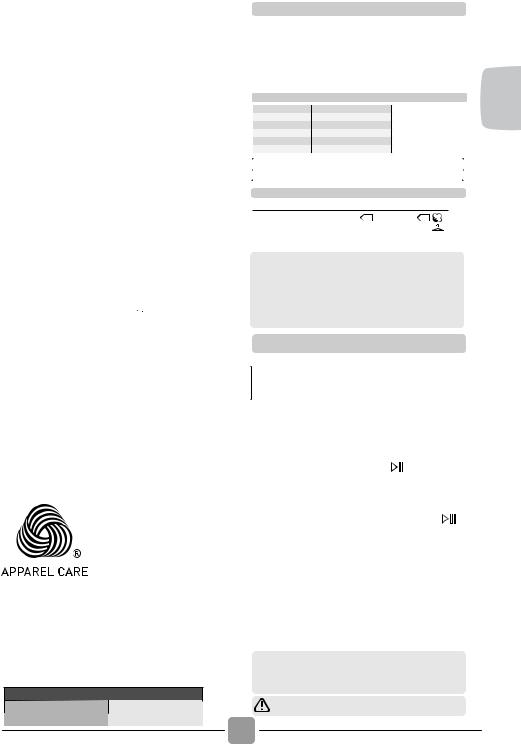
7. Sécurité enfants Cette fonction permet de verrouiller le bandeau de commande pendant le cycle de séchage, afin d'éviter tout changement indésirable de paramètres. Activer/désactiver:
Appuyez sur les boutons 4 et 5 simultanément pendant deux secondes. La mention "LOC" apparaît sur l'écran. Lors de la désactivation de la fonction, la mention "Unl" apparaît sur l'écran. En cas d'ouverture de la porte avec la sécurité enfants activée, le cycle s'arrête mais le verrouillage reste. Pour redémarrer le cycle, désactivez la sécurité enfants et appuyez sur
"DEMARRER". Lorsque le sèche-linge est éteint, l'option est automatiquement inactive. La sécurité enfants peut être modifiée à n'importe quel moment du cycle.
8.Démarrer SMART TOUCH
Appuyez simultanément sur les boutons DEPART/PAUSE et OPTIONS. Cela lancera le dernier cycle de lavage qui a été téléchargé avec l ' a p p l i c a t i o n s i m p l y - F i ( p o u r p l u s d e renseignements reportez-vous à la section Smart Touch de la notice d'utilisation).
D- LEDS
Bac de récupération d'eau - Une LED s'allume lorsque le bac de récupération d'eau doit être vidé
- Une LED s'allume lorsque le bac de récupération d'eau doit être vidé
Nettoyage des filtres  - Une LED s'allume lorsque les filtres doivent être nettoyés (filtres de porte et du bas)
- Une LED s'allume lorsque les filtres doivent être nettoyés (filtres de porte et du bas)
Refroidissement  - Une LED s'allume lorsque le cycle est en phase finale de refroidissement
- Une LED s'allume lorsque le cycle est en phase finale de refroidissement
E- ZONE SMART TOUCH - Appuyez sur le bouton DEMARRER/PAUSE et positionnez la manette sur le programme Touch. Cette manipulation permet de lancer directement un programme téléchargé en amont. (Pour télécharger de nouveaux programmes sur l'application, voir la notice d'utilisation)
Le cycle de séchage Laine de cette machine a été approuvé par The Woolmark Company pour
le séchage des produits en laine lavables en machine, a condition que
les produits soient lavés et séchés selon les instructions données sur l'étiquette du vêtement et celles émises par le fabricant de cette machine. M1530.
Au Royaume-Uni, en Irlande, à Hong Kong et en Inde la marque Woolmark est une marque de certification.
Poids De Séchage Maximum
Coton |
Capacité max. déclarée |
Synthétiques ou Délicats |
Max.4 Kg |
Guide De Séchage
Le cycle normatif COTON ECO (  ) est le plus économe et le plus approprié pour le séchage des textiles cotons. Le tableau sur la dernière page vous montre les durées et la consommation approximative des principaux programmes de séchage.
) est le plus économe et le plus approprié pour le séchage des textiles cotons. Le tableau sur la dernière page vous montre les durées et la consommation approximative des principaux programmes de séchage.
Spécifications Techniques
Capacité du tambour |
78,5 |
|
|
Charge maximale |
Se reporter à l'étiquette énergétique |
|
|
Hauteur |
85 cm |
|
|
Largeur |
60 cm |
|
|
Profondeur |
48,7 cm |
|
|
Étiquette d'énergie |
Se reporter à l'étiquette énergétique |
|
|
|
|
|
|
Leistungsaufnahme im Aus-Zustand |
|
0,40 W |
|
Leistungsaufnahme im unausgeschalteten Zustand |
0,75 W |
||
Information pour le laboratoire de test
EN 61121 Programme à utiliser
-COTON EXTRA SEC |
COTON OU |
-COTON PRÊT A REPASSER |
COTON OU BLANC |
-TEXTILE DELICAT |
-DELICATS OU SYNTHETIQUES |
 La durée réelle du cycle dépend du niveau d'humidité du linge en sortie d'essorage, du type de linge, de la charge, de la propreté des filtres et de la température ambiante
La durée réelle du cycle dépend du niveau d'humidité du linge en sortie d'essorage, du type de linge, de la charge, de la propreté des filtres et de la température ambiante
FONCTIONNEMENT
1.Ouvrez la porte et chargez le linge dans le tambour. Vérifiez qu'aucun vêtement n'entrave la fermeture de la porte.
2.Fermez doucement la porte en la poussant jusqu'à ce que vous entendiez un déclic.
3.Tournez le sélecteur de programme et
choisissez le programme de séchage s o u h a i t é ( c o n s u l t e z l e g u i d e d e programmation pour de plus amples détails)
4. Appuyez sur le bouton Le sèche-linge démarre automatiquement et le voyant situé au dessus du bouton s'allume.
5. Si vous ouvrez la porte pendant le cycle de séchage pour vérifier le linge, il est nécessaire d'appuyer sur le bouton , pour recommencer le séchage une fois la porte refermée.
6.Lorsque le cycle est presque terminé, la phase de ventilation à froid commence. Les vêtements sont séchés avec de l'air froid afin de les refroidir.
7.Lorsque le programme est terminé, le
voyant END s'allume sur le bandeau de commande.
8. A la fin du cycle, le tambour continuera à tourner de manière intermittente afin de minimiser les plis. Cette opération continuera jusqu'à ce que l'appareil soit éteint ou que la porte soit ouverte.
 Ne pas ouvrir la porte durant les programmes automatiques afin d'obtenir un séchage performant
Ne pas ouvrir la porte durant les programmes automatiques afin d'obtenir un séchage performant
Limpe os filtros antes de cada ciclo
FR
29

8. SÉLECTION DU PROGRAMME
PROGRAMME |
DESCRIPTION DU PROGRAMME |
CAPACITE |
TEMPS DE |
|
(kg) |
SECHAGE |
|||
|
(min) |
|||
|
|
|
|
|
|
Un programme adapté au séchage des textiles mixtes. Les plis |
2 |
* |
|
|
sont minimisés grâce à une humidité optimale du linge pour |
|||
|
faciliter le repassage. Secouer le linge avant séchage. |
|
|
|
|
Programme de séchage normatif économique. Le programme le |
5 |
* |
|
|
moins énergivore. Convient aux vêtements en coton et lin. |
|||
|
|
|
|
|
|
Le cycle adapté au linge en coton ainsi qu'aux tissus spongieux |
MAX |
* |
|
|
et les serviettes. |
|||
|
Pour sécher tous les différents types de tissus comme le |
4 |
* |
|
|
coton, le lin, le mixte, les matières synthétiques. |
|||
|
|
|
|
|
|
Cycle conçu pour sécher les tissus délicats et synthétiques |
4 |
* |
|
|
qui nécessitent un traitement précis et spécifique |
|||
|
|
|
|
|
|
Ce cycle est spécialement dédié au séchage des chemises et |
2.5 |
|
|
|
minimise les plis grâce aux mouvements spécifiques du tambour. Il |
* |
||
|
est recommandé de sortir le linge directement après la fin du cycle. |
|
|
|
|
Un cycle délicat spécifique pour sécher les vêtements en coton |
4 |
* |
|
|
foncé ou coloré. |
|||
|
Cycle dédié aux vêtements pour bébé qui ont besoin d'être |
4 |
150’ |
|
|
hygiénisés. |
|||
|
|
|
|
|
|
Cycle dédié aux textiles en jean ou denim. Il est recommandé de |
4 |
* |
|
|
mettre les vêtements sur l'envers avant de les sécher. |
|||
|
Cycle pour les vêtements techniques de sport et de fitness. |
4 |
|
|
|
Sèche en douceur et respecte les fibres élastiques en |
* |
||
|
empêchant les plis et la détérioration des textiles. |
|
|
|
|
Grâce à la certification Woolmark, ce programme permet de sécher |
|
|
|
|
jusqu'à 1kg de vêtements délicats en laine (environ 3 pulls). Il est |
|
|
|
|
conseillé de mettre les vêtements sur l'envers avant de les sécher. |
|
|
|
|
La durée du cycle peut varier en fonction des dimensions du linge, |
|
|
|
|
du poids de la charge et du niveau d'essorage choisi durant le |
|
|
|
|
lavage. A la fin du cycle, les vêtements sont prêts à être portés. |
1 |
70’ |
|
|
Cependant si le textile est plus lourd, les extrémités peuvent être |
|||
|
encore humides. Laissez les alors sécher naturellement. Il est |
|
|
|
|
recommandé de décharger le linge tout à la fin du cycle. Attention: |
|
|
|
|
le feutrage de la laine est irreversible ; ne sécher que les vêtements |
|
|
|
|
avec le symbole ("séchage autorisé en sèche-linge"). Ce |
|
|
|
|
programme n'est pas conçu pour les vêtements en acrylique. |
|
|
|
|
|
|
|
|
|
Un cycle spécifique qui sèche tout en contribuant à réduire les |
4 |
220’ |
|
|
principaux allergènes comme les poussières, les poils |
|||
|
d'animaux, les pollens et les résidus de lessive. |
|
|
|
|
Il s'agit d'un cycle chaud qui en seulement 12 minutes aide à |
2.5 |
12’ |
|
|
détendre les plis. |
|||
|
|
|
|
|
|
|
|
|
|
|
Le cycle idéal pour éliminer les mauvaises odeurs et défroisser le |
2.5 |
* |
|
|
linge. |
|
||
Il s’agit de programmes supplémentaires que vous pouvez télécharger depuis votre Smartphone grâce à l’application Simply-Fi (pour plus d’information voir la partie Smart Touch de la notice). Le programme Auto-nettoyage est installé par défaut pour entretenir votre machine.
* La durée réelle du cycle dépend du niveau d'humidité du linge en sortie d'essorage, du type de linge, de la charge, de la propreté des filtres et de la température ambiante.
30
